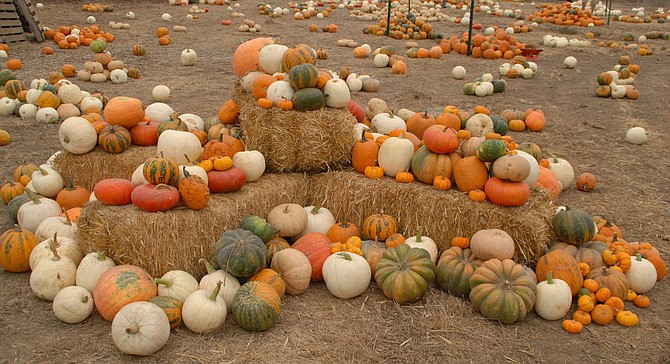 Facebook
Facebook
 X
X
 Instagram
Instagram
 TikTok
TikTok
 Youtube
Youtube

October in San Diego continues the transition between summer and winter crops, so everybody’s breaking out the winter squash. While gourds aren’t something we automatically think about in terms of organics, winter squash is actually up there with spinach and green beans on the list of conventionally grown vegetables that retain the highest levels of pesticide residue. So this month we’re looking exclusively at organics.
Adam Maciel’s farm actually has both green beans and spinach coming in October, while its winter squash varieties include butternut, acorn and spaghetti squash, famous for stringy flesh that doubles as a pasta replacement.
Obviously, there’s one big orange gourd that dominates our October landscape. Actually, make that two orange gourds — both of them pumpkins.
While most October pumpkin purchases are made in the name of Halloween, these are considered carving pumpkins, bred to make better jack-o-lanterns, not taste good. While their seeds roast up just fine, carving pumpkins are grown for size, promoting thin shells to make spooky knifework easier. Consequently, they wind up being relatively hollow, with smaller amounts of grainy, watery flesh. Not good pie material.
Pie pumpkins tend to be smaller and denser like other gourds, yielding more flesh per pound, and finer texture. As pie pumpkins skew sweeter, they’re sometimes referred to as sugar pumpkins. And you may find organic pie pumpkins at farmers' markets.
JR Organics stands will be offering offer both kinds of pumpkin this month, to go with its own butternut, acorn, and spaghetti squash. Maciel’s is focusing on the sweet pie pumpkins, not jack-o-lanterns. They’re not just for pies, either — the Maciels report one creative customer selected eight of these smaller pumpkins in the same size, so she could serve pumpkin soup inside their shells to dinner guests.
Both Stehly Farms and Suzie’s Farm offer pumpkin patch events in October. Suzie’s hosts Pumpkin Palooza from 10am-2pm each Saturday between October 8 and 22. The free events feature live music and plenty of what Suzie’s likes to call porch pumpkins for carving, including the polar bear pumpkin, which has white skin that glows orange when a candle’s placed inside.
Per usual, Suzie’s also has a great deal of interesting edible varieties, including the triamble pumpkin — a peculiar looking blue pumpkin with dense sweet flesh — and porcelain doll, which is pale pink sometimes moving into a blue or green shade. Both are great for pies. The French musquee de Provence pumpkin is a favorite for soups and sauces, and looks like something out of a storybook, with squat, thick lobes — Cinderella’s fairy godmother might easily turn it into a carriage.
There’s also a breed called Cinderella pumpkin, one of many available when Stehly Farms welcomes pumpkin pickers to its patch in Valley Center October 9. A small fee includes access to a petting zoo, corn maze, and a chance to pick pumpkins both for eating and for carving.


October in San Diego continues the transition between summer and winter crops, so everybody’s breaking out the winter squash. While gourds aren’t something we automatically think about in terms of organics, winter squash is actually up there with spinach and green beans on the list of conventionally grown vegetables that retain the highest levels of pesticide residue. So this month we’re looking exclusively at organics.
Adam Maciel’s farm actually has both green beans and spinach coming in October, while its winter squash varieties include butternut, acorn and spaghetti squash, famous for stringy flesh that doubles as a pasta replacement.
Obviously, there’s one big orange gourd that dominates our October landscape. Actually, make that two orange gourds — both of them pumpkins.
While most October pumpkin purchases are made in the name of Halloween, these are considered carving pumpkins, bred to make better jack-o-lanterns, not taste good. While their seeds roast up just fine, carving pumpkins are grown for size, promoting thin shells to make spooky knifework easier. Consequently, they wind up being relatively hollow, with smaller amounts of grainy, watery flesh. Not good pie material.
Pie pumpkins tend to be smaller and denser like other gourds, yielding more flesh per pound, and finer texture. As pie pumpkins skew sweeter, they’re sometimes referred to as sugar pumpkins. And you may find organic pie pumpkins at farmers' markets.
JR Organics stands will be offering offer both kinds of pumpkin this month, to go with its own butternut, acorn, and spaghetti squash. Maciel’s is focusing on the sweet pie pumpkins, not jack-o-lanterns. They’re not just for pies, either — the Maciels report one creative customer selected eight of these smaller pumpkins in the same size, so she could serve pumpkin soup inside their shells to dinner guests.
Both Stehly Farms and Suzie’s Farm offer pumpkin patch events in October. Suzie’s hosts Pumpkin Palooza from 10am-2pm each Saturday between October 8 and 22. The free events feature live music and plenty of what Suzie’s likes to call porch pumpkins for carving, including the polar bear pumpkin, which has white skin that glows orange when a candle’s placed inside.
Per usual, Suzie’s also has a great deal of interesting edible varieties, including the triamble pumpkin — a peculiar looking blue pumpkin with dense sweet flesh — and porcelain doll, which is pale pink sometimes moving into a blue or green shade. Both are great for pies. The French musquee de Provence pumpkin is a favorite for soups and sauces, and looks like something out of a storybook, with squat, thick lobes — Cinderella’s fairy godmother might easily turn it into a carriage.
There’s also a breed called Cinderella pumpkin, one of many available when Stehly Farms welcomes pumpkin pickers to its patch in Valley Center October 9. A small fee includes access to a petting zoo, corn maze, and a chance to pick pumpkins both for eating and for carving.
Comments